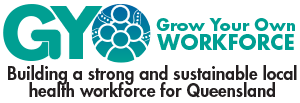About Grow Your Own
It is widely acknowledged that strategic workforce planning and development will be a key enabler as Queensland’s health sector works towards building the foundations necessary to effectively deliver services that meet the health needs of all Queenslanders.
The intent of this resource, which has been developed with funding from Queensland Health and in consultation with industry, is to strengthen the Queensland health sector’s efforts to develop a capable and sustainable local health workforce. Designed to be a one-stop shop, it includes practical workforce planning tools, Grow Your Own (GYO) guides, information about funding for recruitment and training, useful contacts and good practice case studies.
WHAT IS MEANT BY GROW YOUR OWN (GYO)
GYO is a term used to describe a place-based workforce model that focuses on attracting, developing, supporting and retaining local residents, at any level and in any discipline, in an effort to create a sustainable pipeline of workers. It essentially involves two separate but complementary approaches, namely an outside-in and an inside-up approach.
Outside-in approach
An outside-in approach is when an employer looks to fill a position with a suitable person outside the business. It involves strategies to increase attraction, development and inclusive employment opportunities specifically for locals. In many instances, local job seekers may have otherwise faced barriers to employment. An inclusive recruitment approach allows and encourages people of all working ages, and socioeconomic and cultural backgrounds to participate in paid work, and provides a framework for their development.
Inside-up approach
A GYO program should not end once a local candidate is employed. Outside-in strategies should be complemented by inside-up initiatives that focus on the retention and advancement of local employees. Through succession planning, mentoring, training, job coaching and career progression opportunities, an organisation can keep the local workforce pipeline moving.
The GYO model is not a one-size fits all approach. The reality is that successful GYO models require a diversity of programs, networks and relationships. It is also not a quick-fix solution that will immediately fill workforce supply gaps. Instead, it should be viewed as a long-term approach that takes a strategic view of establishing a sustainable pipeline of local workers for a range of positions, from administration to practitioner.
Not only can place-based workforce initiatives address critical workforce gaps but they can also potentially deliver broader health, economic, education and social and community benefits. As such, the value of implementing a GYO program is not exclusive to the health industry.
While a traditional recruitment strategy is focused on what skills are needed and can be imported regardless of where the candidate is based, the characteristics of a GYO workforce model are as follows:
CHARACTERISTICS OF A GYO WORKFORCE MODEL | |
Area of focus |
It is a place-based approach that targets people in a specific region or community, identifying employment needs and barriers to employment and building programs to help address those needs and barriers. |
Resource focus | Maximising existing community strengths by creating partnerships with community stakeholders who share a common agenda and are committed to working collaboratively to resolve the workforce problem. |
Policy focus | Establishing and entrenching organisational policies to ensure recruitment of local labour is a strategic business priority, inclusive and extended to the disadvantaged; i.e. underemployed, unemployed and minority groups. Inclusive local recruitment should be an organisation-wide aspiration with support, co-operation and by-in from the organisation’s leadership team and relevant staff. |
Model strength | A place-based approach builds a more diverse, stable workforce that better understands the local environment and the community they serve, and helps create a more sustainable business and stronger community with long-term stability. Growing a local workforce within the community may take time but can result in improved service delivery and long-term flow on health, economic, social and educational benefits for the community. |
